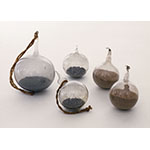Set of eighteen small spheres, some containing lead pellets, others sawdust. Used to examine the specific gravity of different fluids, particularly water. The invention of this type of hydrometer is attributed to Ferdinand II de' Medici, who perfected it during the experimentation program that he sponsored in the year prior to the founding of the Accademia del Cimento. On the neck of the spheres were placed six identical brass rings which, together with the sphere, weighed exactly one ounce. Such spheres were accordingly called "ounce to weigh waters and all the other liquids"—hence the name palle d'oncia [ounce balls], used to designate the instruments. Once the hydrometer was immersed in a liquid, ever-smaller rings were added so as to keep the top of the neck under the surface of the liquid. When the liquid was changed, the difference in the number of rings needed to keep the sphere under the surface indicated the difference in density between the liquids.










